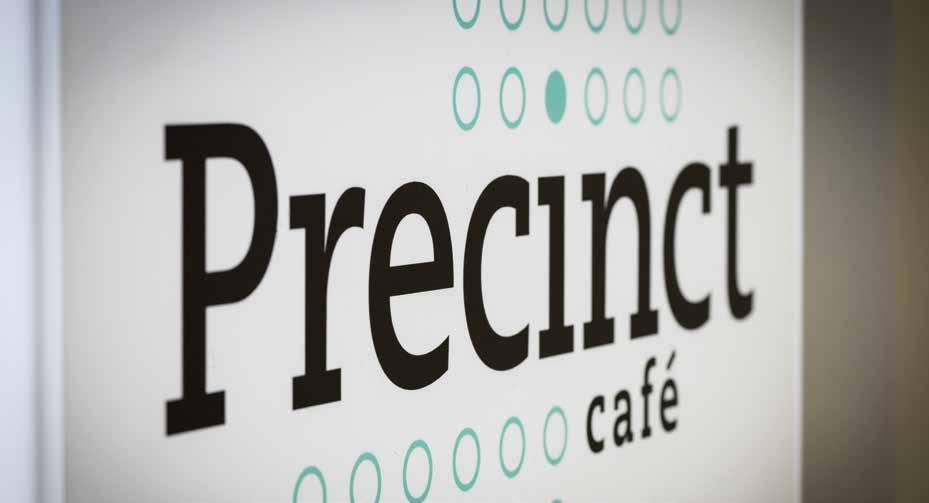The



“(It) would be against the public interest, a risk to public safety, and could result in public disturbance.”
beer-can






The Police Association Members Buying Guide offers members and their families massive exclusive discounts on a wide range of goods and services.

The easiest way to access all the discount codes is to join the private Facebook Group at facebook.com/groups/ membersBuyingGuide
Or access the codes by logging on to the Police Association website (pasa.asn.au) and navigating to the Member Services tab.

The dangerous, unthinking act of throwing full cans of alcohol at police, athletes and spectators at sports stadia happens all around the world And now, owing to a liquor licence variation, there’s the potential for it to happen on game days at Adelaide Oval.
Yes, cans are on sale at the ground. And only the Police Association and one state parliamentarian have worked – and continue to work – hard to get that reversed. SAPOL, on the other hand, withdrew an initial objection and is now okay with can sales.
For our cover story, Police Association president Mark Carroll explained the union’s opposition to the licence amendment The Adelaide Oval Stadium Management Authority and SAPOL declined interviews
The Police Association and Police Credit Union continue to keep their extraordinary bond in place and to come up with joint initiatives to benefit members Their most recent step in that direction is a new sponsorship agreement set to run for four years
Melody Horrill certainly made an impact with not only the interview she gave the Police Journal this year but also her memoir, A dolphin called Jock We were delighted to welcome her back to the Police Association of which she now feels a part.
Police Association deputy president Wade Burns makes some of the most meaningful observations of members who repeatedly commit themselves to their work over Christmas
Police Association president Mark Carroll provides a snapshot of the results which came out of the PricewaterhouseCoopers review of the association
brettwilliams@pjPublisher: Police Association of South Australia Level 2, 27 Carrington St, Adelaide SA 5000 T (08) 8212 3055 F (08) 8212 2002 www.pasa.asn.au Editor: Brett Williams (08) 8212 3055 Design: Sam Kleidon 0417 839 300 Advertising: Police Association of South Australia (08) 8212 3055 Printing: Finsbury Green (08) 8234 8000
The Police Journal is published by the Police Association of South Australia, 27 Carrington St, Adelaide, SA 5000, (ABN 73 802 822 770). Contents of the Police Journal are subject to copyright. Reproduction in whole or in part without written permission of the Police Association of South Australia is prohibited. Opinions expressed are not necessarily those of the editor. The Police Association accepts no responsibility for statements made by advertisers. Editorial contributions should be sent to the editor (brettwilliams@pj.asn.au).
Police Association 6
President 10
Top-level review endorses Police Association methods
Industrial 22 Regional on-call and fatigue risks
Cops’ Christmas sacrifice Health 25 Noisy environments a danger to hearing
Motoring 26 Subaru WRX Honda HR V Legal 31 Driving laws too complicated? Books 32 Cinema 34 DVD 36 Wine 37 On Scene 40
The Last Shift 44
Jobs you never forget 46

It seems Commissioner Grant Stevens is prepared to risk it, despite the potential for a police officer to cop a flying beer can in the head
19 Sponsorship: founders would have approved
The Police Association and Police Credit Union have struck a new agreement which has strengthened their bond and will, of course, benefit association members
A grateful Melody Horrill came back to the Police Association to hand a signed copy of her book to the president.
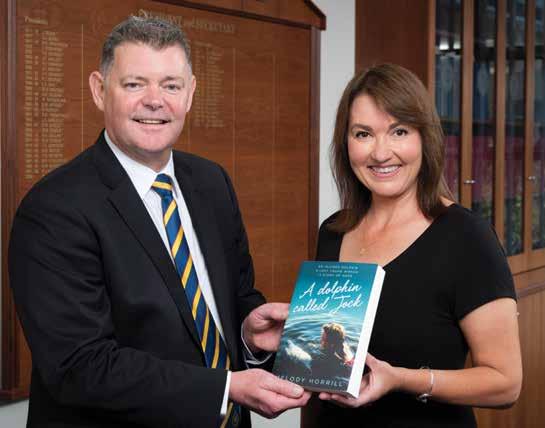


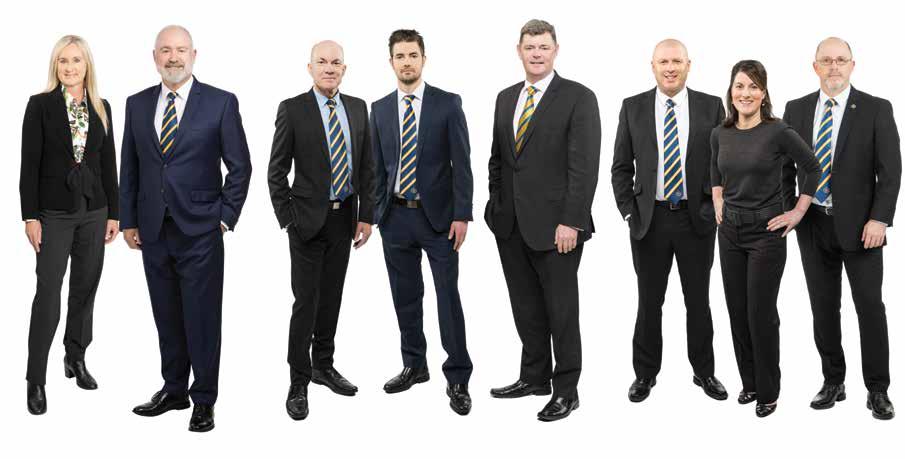



Superannuation
Mark Carroll and Michael Kent
Police Dependants Fund Bernadette Zimmermann
Leave Bank Andrew Heffernan
Country housing Andrew Heffernan
Commissioner’s Office Health Safety & Welfare Advisory Committee Steven Whetton Legacy Julian Snowden
Sexual Orientation, Gender Identity & Intersex members Nadia Goslino and Andrew Heffernan
Metro North Branch
Elizabeth Nick Sipovac Gawler Andrew Wearn
Golden Grove Darren Quirk Henley Beach Sean Hobbs Holden Hill Cameron Scott Northern Prosecution Tim Pfeiffer
Parks Matthew Sampson Salisbury Stuart Smith
Country North Branch Ceduna Anthony Taylor Coober Pedy Clinton McClure Kadina Gavin Moore Nuriootpa Andrew Dredge Peterborough Nathan Paskett
Port Augusta Peter Hore
Port Lincoln Mark Heading
Port Pirie Gavin Mildrum Whyalla Paul Velthuizen
Crime Command Branch
Adelaide Alex Grimaldi
Elizabeth Joel Manson
Forensic Services Kristin Enman
Fraud Sam Agostino
Intel Support Robert Alderson
Major Crime Phil Buttfield
Port Adelaide Scott Mitchell
Metro South Branch Hindley Street Dick Hern Netley Paul Clark Norwood Jason Griffin Southern Prosecution Sallie McArdell Southern Traffic Joshua O’Dwyer Sturt David Handberg
Country South Branch Adelaide Hills Joe McDonald Berri John Gardner Millicent Tanya Payne Mount Gambier Robert Martin Murray Bridge Aaron Galwey Naracoorte Michael Hutchinson Renmark James Bentley South Coast Andrew Bradley
Operations Support Branch
Dog Ops Bryan Whitehorn (chair) Academy Melanie Smith ACB Tony Boots
Band Adam Buckley
ComCen Vilija Sabeckis
ComCen Glenys Moriarty
Human Resources Eugene Wasilenia
Mounted Ops Sonia Wellings
STAR Andrew Suter
State Tac/Op Mandrake Duncan Gerrie Traffic David Kuchenmeister
Officers Branch Les Buckley
Women’s Branch Kayt Howe (chair) (no delegates)

It also provided enormous assistance to the association in outlining several areas upon which we can improve, get even stronger, and make even better operational decisions in the interests of our members
Every organization can and should learn from introspection Indeed, the committee will investigate the review’s recommendations with a view to building further upon the association’s internal operations.
No doubt members will reflect on 2022 as the year SAPOL suffered owing to some of the most self-sabotaging policies and crippling bureaucracy one could ever imagine
The failing district policing model, staff shortages, COVID-19 policies and falling way behind on recruiting were among the many SAPOL problems which were obvious to everyone except, it seemed, the organization itself.
I
t is often only when something has gone horribly wrong that an organization orders an independent review
Of course, by then, it’s too little, too late
I’ve been determined not to allow that to happen at the Police Association And every individual on the committee of management holds firmly to that position
Though we’ve enjoyed a long track record of industrial successes over the last two decades, it doesn’t make us immune from some of the issues that can beset even the most well-oiled operations.
I’m always cognizant of organizations which become victims of their own successes, as they develop a mindset which is too insular
Leaders can, indeed, get too comfortable with their way of thinking They can start to believe their own publicity: “We are successful, so we should always repeat what we think works ”
But that doesn’t guarantee success into the future. Times change, processes evolve, logistics have to be maintained.
Put simply: the association shouldn’t ever rest on its laurels. Our members expect better than that — and they should
That’s why we engaged top accounting firm PricewaterhouseCoopers to conduct an independent review of all operations earlier this year
PwC has recently completed the review and the results are very pleasing for the association
Our position, both financially and operationally, is strong
Overall, the review revealed that the association’s purpose is clearly defined, and that key staff and leaders within the organization possess extensive industry knowledge
It also highlighted that the organization’s policies and processes are clear and precise —not bogged down by bureaucracy and unnecessary red tape
And it is no secret that one of the major strengths of the association is the tenure and loyalty of its individual staff members
Members who have interacted with our staff on both an industrial and administrative level would have seen how knowledgeable and efficient they are. So, it came as no surprise that the review pinpointed this as one of the association’s key strengths
While all this was occurring — and amid an unprecedented number of member absences and shortages — the association conceived what we called a premier’s taskforce and took the idea to major stakeholders within political parties in the lead-up to the March state election
The taskforce would review and make recommendations on increasing the number of sworn officers and police security officers recruited over the next decade. It would also give government some much-needed guidance in respect of policing needs for ever-expanding populations and districts.
The Malinauskas government agreed with the idea and implemented the taskforce earlier this year
The taskforce will address many issues, including staffing and recruiting
This is a great result for SA police officers, but it’s disappointing that it needed to happen, and that the association had to force the issue
Incumbent upon the SAPOL leadership now is to acknowledge how widespread some of these problems are, then commit to working with the association on clear, succinct and practical solutions. This will be the way forward
To be clear, we don’t want to play the antagonist on this issue We want SAPOL to get better Much better The mental and physical health of our members — and community safety — depends on it
Another of our important wins came this year when the state government reimbursed $1 7 million to the Police Association over the botched Mantle investigation.
We were never going to let this one go.
It was a six-year probe and every officer involved was either acquitted or had charges dropped The incoming state government deserves credit for its swift action in arranging the reimbursement
A couple of other significant events marked the association’s year as well
There was the release of our new strategic plan which covers our next four years of operation.
Results must continue to flow and, as an organization, we must be continuously improving and adapting to change in society and the workplace The new strategic plan serves as the road map for that purpose
On a much sadder note, 2022 marked the closure of the Police Club after more than 60 years of operation.
It was not an easy decision for us to make but, sadly, it reflected commercial realities and the club’s lack of viability.
The club was an institution in South Australia It has left us with wonderful memories, and we will miss it intensely
The committee of management is currently assessing the future use of the space and has engaged property experts to assist in that regard
Also abundantly clear, as we head into 2023, is that the association has courageously stood tall, and often alone, on several significant issues in the last 12 months
At times, it would’ve been more comfortable to take the easy path, to not bother pursuing SAPOL, the government, and other stakeholders over bad or unjust policies which seriously hurt our members

But that’s not how this association operates It doesn’t, and never has, put members’ issues into the too-hard basket
Thankfully, we have an incredible team of staff who fully buy into this philosophy.
Our delegate contribution has also been exceptional in the last 12 months — courageous, organized and possessed of sound judgement
But what makes the Police Association the most effective union in this state is its most valuable asset: the members
This organization has a membership rate of more than 97 per cent This is what makes us a force to be reckoned with in SA It’s why we wield such influence . It’s why SAPOL, the government, and other stakeholders readily come to the table to negotiate with us.
As the festive season and 2023 approach, I know many of our members will be working, sacrificing family time they will never get back
Crime doesn’t stop for the holiday season Arrests still need to be made Road accidents still occur Calls to 000 still have to be answered.
And it is association members who will respond to these jobs around the clock to keep South Australians safe.
They deserve every ounce of support and, indeed, gratitude the community can offer
I wish all our members and other loyal readers of the Police Journal a safe and enjoyable Christmas-New Year season
See the completed PwC review and the Strategic Plan 2022-2025 on PASAweb.

Itwas a statement intended to reassure listeners of his concern for cops in their daily struggle on the front line “I feel really strongly about the safety of police officers,” Commissioner Grant Stevens claimed in a breakfast radio interview in 2018.
“Police officers … have a right to expect that they’re going to be protected when they’re entering into violent or dangerous situations ”
His position seemed pretty clear – until he came to the point of the question the radio hosts had asked him It was about an on-duty cop slugged in the face one night in Hindley St in March 2017

And, as Stevens continued his answer, he indicated his support for a decision not to prosecute the offender for assault police
Three years earlier, police had hoped Stevens would back them in their battle to regain lost compensation entitlements under the Return to Work Act. When it came to the crunch, however, he sided not with working cops but rather the Weatherill government
Stevens had to have known that police would question these decisions and, indeed, his claim of care about their safety Another of his decisions has had them asking questions again this year
Their concern follows a controversial application by the Adelaide Oval Stadium Management Authority to vary its liquor licence.

The SMA was seeking the right to reintroduce the sale of alcohol in aluminium cans at the oval SAPOL initially opposed the move and filed a notice of intervention
By Brett WilliamsIts Licensing Enforcement Branch even sought support for its position from police unions, including the Police Federation of Australia
No police union wanted to see cans in the grasp of spectators who could easily hurl them at police and others at Australian sports grounds. Police Federation of Australia board members made that clear through a unanimous vote at an executive meeting in Adelaide on June 29
But Stevens ultimately chose not to object to the SMA application, despite the duty of care he owed his police employees who stood to become the targets of can-throwers
His explanation, in a breakfast radio interview in August, was that his Licensing Enforcement Branch had undertaken negotiations with the SMA . In fact, in mid-July, LEB officer-in-charge Chief Inspector Greg Hutchins had invited SMA lawyers to talk through the issues.
“They’ve come up with a range of measures that would ensure, or enhance, public safety and minimize the risk of injury (from) the sale of alcohol in aluminium cans,” Stevens said
At the end of the interview, he claimed to be “as concerned about public safety and the safety of police officers as anyone else”
Assistant Commissioner Linda Fellows had given the media some details about that “range of measures” a few days earlier.
She told the Sunday Mail that it included a 12-month trial of the can sales, extra security arrangements, and the continuing service of alcohol in cups
“… and (the SMA) could cease service of cans at any time if SAPOL held concerns during any particular event,” she said
But what Stevens and Fellows outlined did not convince experienced front-line police, who knew better They knew that none of those measures would stop rabid spectators from hurling full cans of beer at them and others on game days
Sergeants Tony Coad and Paul Blenkiron know the psyche of the ill-behaved spectator better than anyone. They have nearly three decades of Adelaide Oval game-day experience between them
“...a full beer can as a thrown projectile can be very dangerous. And that’s not only to members of the public but also police...”
Coad remembers one incident which quickly turned violent, as it can with drunk, aggressive spectators at big Adelaide Oval events like the Showdown
He and his colleague ended up grappling with two aggressors on the ground behind the Western Stand The officers had been in the process of escorting them out of the grounds for defying non-smoking rules.
Coad called for urgent assistance as a crowd started building around the struggling cops and their offenders. He expected that some of the onlookers would at any moment jump in and help him and his partner do their duty
But all the officers got from the crowd were jeers and abuse
“I was shocked that one of the people screaming and yelling was a quite well-dressed, middle-aged man with his 20-something son,” Coad recalls “He just had that look of aggression as he screamed abuse at us. ”
And certain cricket supporters are among those Blenkiron rates well down on the behavioural scale
“The cricket can be quite problematic with people sitting in the sun all day having a few beers,” he explains
“There’s definitely a mob mentality that can get into a crowd pretty quickly Your run-of-the-mill citizen, who would normally not do something stupid, can just get caught up in the heat of the moment
“That’s when things can happen, and a full beer can as a thrown projectile can be very dangerous. And that’s not only to members of the public but also police, who are generally public enemy number one if they’re making an eviction ”
1: New York City FC midfielder Jesus Medina (19) is hit by a beer can that was thrown by a fan after a goal by New York City FC forward Valentín Castellanos (11) during the MLS Cup Final between the Portland Timbers and New York City FC on December 11, 2021 at Providence Park in Portland, Oregon (photo by Brian Murphy/Icon Sportswire via Getty Images). 2: Medina lies injured after being hit in the face with the beer can (photo by Steph Chambers/Getty Images). 3: Groundskeepers pick up bottles thrown from the stands on the 16th hole after a hole-in-one by US player Sam Ryder during the third round of the WM Phoenix Open at TPC Scottsdale on February 12, 2022 in Scottsdale, Arizona (photo by Mike Mulholland/Getty Images). 4: Ben Kennedy of the Jets picks up a can of beer thrown onto the field of play by a Sydney FC fan during the round 15 A-League match between Sydney FC and Newcastle Jets at WIN Stadium on January 3, 2015, in Wollongong (photo by Brendon Thorne/Getty Images). 5: Michael Bevan (centre) holds his face after being hit by a beer can thrown onto the balcony during the post-match presentation ceremony after the NatWest Series final at Lord’s (photo by Nick Potts – PA Images/PA Images via Getty Images).
It all leads Police Association president Mark Carroll to ask: “Why in the world would anyone arm these people with potential missiles like aluminium cans of beer?” Front-line cops have asked – and continue to ask – the same question


Still, on July 27, Liquor and Gambling Commissioner Dini Soulio granted the SMA licence variation – without objection from Stevens. So, the SMA now has the go-ahead to sell those cans.
Soulio indicated that he had considered the “very low occurrence of alcohol-related incidents involving aluminium cans historically”
He pointed to the safety measures of today, such as security personnel and CCTV monitoring, and how “significantly different” these are from the measures of four and five decades ago
What he did not, and could not, say was that these measures would prevent can-throwing incidents. And police unions have been at pains to point out that such incidents continue to occur wherever can sales exist
“If he’s inclined to throw it at the umpire or a player, no beefed-up penalty is going to stop him.”Sergeant Tony Coad Sergeant Paul Blenkiron
At a recent Major League Baseball game in San Diego, a spectator threw a beer can onto the field and just missed a Los Angeles Dodgers player
At a PGA event in Arizona in February, spectators celebrated after golfer Carlos Ortiz hit a hole-in-one – he copped a beer can in the back of his head.

In a Major League Soccer final in Portland last December, a spectator threw a can which hit New York City player Jesús Medina While Medina lay flattened on the pitch, a spectator threw another can at a group of his teammates


And spectators launched beer cans at umpires at Oracle Park in San Francisco last October, after a controversy at the end of a Giants-Dodgers match
The crime has a history on Australian sports grounds too. After now former Rugby League player Wally Lewis copped a send-off at Lang Park in 1988, spectators hurled beer cans onto the arena
And, in 2001, a spectator threw a full can of beer at now former cricketer Michael Bevan at Lord’s The can hit him in the face


With the SMA variation granted, Carroll responded immediately In the media, he echoed the concerns of association members
He insisted that the sale of cans at the oval was against the public interest and a “significant risk” to police, players and officials
Of course, the SMA had applied for the same variation two years earlier. Back then, Stevens pushed back and the application failed in August 2020.
His view was that giving it the green light “would be against the public interest, a risk to
public safety, and could result in public disturbance” So, his position this year came as a complete about-face, which staggered the Police Association
Mark Carroll wrote to Stevens to suggest that he owed police officers an explanation for his “failure to prioritize their safety”
“The onus is on you to provide police, to the greatest extent possible, with the ultimate level of workplace safety,” he wrote
“As a police commissioner with more than 40 years’ experience, you must know the threat that alcohol-fuelled revellers armed with full beer cans presents. It is one of the most obvious potential dangers to even the most junior police officers ”
“There’s definitely a mob mentality that can get into a crowd pretty quickly. Your run-of-the-mill citizen, who would normally not do something stupid, can just get caught up in the heat of the moment.”
The SMA had made its second and latest play for the amendment to its liquor licence in May The associated PR spin out of its office was that a move to aluminium cans would prove more environmentally friendly than single-use plastic cups
But Carroll highlighted the availability of options besides cans, such as biodegradable cups
Even SAPOL, before it switched sides, had backed these cups and other options in its June notice of intervention. It supported the introduction of cans with entirely removable lids to reduce them to “open drink container(s)”
In a breakfast radio interview on July 28, SMA chief operating officer Adam Vonthethoff evaded the question of environmental friendliness
But, when it came to the issue of canthrowing attacks on police and others, he made his position clear “I’m not concerned (about that),” he said. “No. ”
Lawyer Jeremy Hill, acting for the SMA, backed up that position in a letter to the licensing commissioner.
“… aluminium cans present no greater risk of use as a projectile than that currently existing from water bottles, soft drink bottles, and plastic cups,” he wrote
Political leaders also seemed unconcerned about the potential for a police officer, player or spectator to cop a flying can in the head and end up hospitalized
Environment Minister Susan Close endorsed a trial of can sales at the MCG She called the test run, which began at the start of the footy season, a “positive initiative”.
“I’ll be raising the possibility of a trial such as this (MCG) one with the (Adelaide Oval) Stadium Management Authority…” she said
And she did In a letter to SMA chief executive officer Andrew Daniels in May, she wrote of her pleasure to learn of the MCG trial of canned alcoholic beverages
“I would be very supportive of such a trial being undertaken at our state’s iconic sporting stadium,” she wrote
Premier Peter Malinauskas expressed a relaxed view about the trial as well
“It’s worthy of examination,” he said in a breakfast radio interview in August. “It’s happening in other parts of the country and we’re happy to see how that trial plays out ”
Opposition leader David Speirs called the return of beer cans to Adelaide Oval “a positive step”, which had his support As for can-throwers, he suggested “it may be worthwhile re-examining penalties…”
Mark Carroll, however, does not believe that looking at penalties, with a view to beefing them up, would achieve anything
“Imagine a Showdown match, with all the passion and high emotion of dyed-inthe-wool supporters,” he says. “It’s the third or last quarter, the scores are close, and there’s an umpire’s decision that enrages an intoxicated spectator
“His mate has just handed him another full can of beer If he’s inclined to throw it at the umpire or a player, no beefed-up penalty is going to stop him The idea, or hope, that it would is ridiculous
“So, too, is the faith SAPOL and the SMA are placing in the measures they think will ‘mitigate the safety concerns’
“The SMA has agreed to broadcast onscreen announcements which warn against using cans as projectiles. But they couldn’t seriously believe that a message akin to a community service announcement will stop an angry, intoxicated can-thrower ”
“The mitigation strategies proposed to offset any potential harms … at the Adelaide Oval from the introduction of canned alcohol beverages are unlikely to be sufficient…” she wrote.
Her report details how those mitigation strategies impose the onus of responsibility on individuals
“(But) decades of research,” she wrote, “clearly show that it is environmental and situational factors that largely drive such individual behaviours, particularly where the consumption of alcohol has been involved ”
The risk-mitigation measures to which the SMA committed itself led Carroll to justifiable frustration in a radio interview He derided the SAPOL negotiations which brought them into play.
“You wouldn’t want this sort of negotiating in a pay round,” he quipped. “You’d come out of it owing money ”
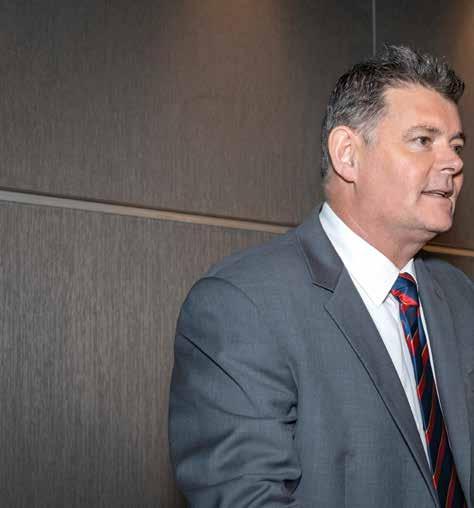
“… they couldn’t seriously believe that a message akin to a community service announcement will stop an angry, intoxicated can-thrower.”
It seemed that only one parliamentarian stood vehemently opposed to the amended SMA licence SA Best MLC Frank Pangallo made his view clear in the same radio interview in which Adam Vonthethoff had participated

He spoke of both government and Opposition silence and what he believed that indicated
“…there’s been some agreement that’s been reached even before it went to the liquor licensing commissioner,” he said.
Pangallo went on to announce his intention to have the SMA called before the parliament’s Budget and Finance Committee
“And, also, I’ll have my staff today start drafting legislation to ban the sale of canned beer … at the Adelaide Oval,” he said “Particularly if it’s going to endanger spectators…”
Pangallo bought into the debate on alternatives to aluminium cans, too In a letter to Dini Soulio, he highlighted two local businesses and their “reusable, re-washable cups”. One even features a patented handle for carrying multiple drinks in one hand
On July 29, the Police Association committee of management met to discuss the approved liquor licence variation From that meeting came unanimous support to seek legal advice on the merits of an appeal against the Soulio decision.
That advice came from barrister Ben Doyle KC . It indicated that the association could only seek a review of the decision with the permission of the Licensing Court
“Had we been a party to the hearing that determined the outcome of the SMA application, we would have had a right of review,” Mark Carroll says “We hadn’t made a submission because SAPOL had given every indication that it intended to challenge the application.
“But, unknown to us, SAPOL had backflipped on that intention. And we only found that out when Licensing Enforcement Branch contacted me on July 22 We then had too little time to prepare and lodge a submission ”
But, in September, the Police Association did get its day in court to seek permission to apply for a review of the Soulio decision
Lawyer Jeremy Hill had left the association in disbelief with earlier arguments he made in favour of the licence variation.
He asserted that less alcohol would be consumed because the cans had a smaller volume than the current
plastic cups Hill also asserted that “cans have a reduced ability for quick consumption given their narrower outlet”
In an Outline of Submissions document, Ben Doyle had indicated that it was “reasonably arguable” that Soulio had erred.
He asserted that, on the limited material before the licensing commissioner, “there was no basis to depart from his earlier conclusion of risk to public safety…”
Licensing Court judge Brian Gilchrist accepted that the Police Association had “… a legitimate interest in the proceedings and in making the … application”
But he also indicated that there was no reason to assume that Soulio did not “independently satisfy himself that it was appropriate” to grant the SMA licence variation Gilchrist dismissed the Police Association application
The association, however, continues to build on its case against selling beer and other alcohol in cans at Adelaide Oval It has never believed that the SMA applied to vary its liquor licence because it had succumbed to environmental consciousness.
“This is about nothing but commercial interests,” Mark Carroll asserts. “The SMA lost millions of dollars in 2020 and ’21 during the COVID-19 pandemic
“As long as the sale of cans is allowed, can-throwing incidents will happen again. And, when they do, and our members are injured, we will hold Commissioner Grant Stevens, the SMA, and the government responsible.”Mark Carroll
“And does anyone really believe that the SMA would have sought the variation unless its board saw a commercial benefit in it?
“Without having to decant beer into plastic cups, bar staff will be able to serve more alcohol more quickly. And, that process will, in all likelihood, require less staff. It all adds up to greater profits ”
In that breakfast radio interview of July 28, Adam Vonthethoff struggled to answer questions about increased revenue from can sales
The exchange went:
David Bevan: “Will you make more money out of selling cans of beer than you currently do selling it in a cup?”
Adam Vonthethoff: “I can’t… it’s not a straight answer, the question to that, in the sense of…”
David Bevan: “Yes, it is. Yes, it is (a straight answer). ”
Adam Vonthethoff: “I wouldn’t… to be honest with you, I wouldn’t think we’d have made more money out of it I think it’s about having a wider range of products there available ”
The interview continued: David Bevan: “So this is not about improving your bottom line as a result of this decision?”
Adam Vonthethoff: “Well, I wouldn’t think so, in the sense of a patron is going to come to the bar. They’ve got to make their choice of beverage products, and they’ll still buy that product ”
Professor Ann Roche, in her report, considered the potential – as Jeremy Hill identified in his letter to Soulio – for the SMA to broaden its range of alcohol in cans
Hill had written: “It … allows stadium management to explore further commercial opportunities with service providers who produce in cans only. ”
Roche wrote: “There are, therefore, potential untapped profit margins that may be derived from any expansion into the provision of spirit-based canned drinks ”
is the link the Roche report highlights between faster service of alcohol –courtesy of cans – and domestic violence
“(The) greater speed of service will likely increase consumption among existing drinkers…” Roche asserts “This, in turn, will likely have knockon effects in terms of increased antisocial behaviour … and increased levels of family and domestic violence.
“The issue of increased levels of family and domestic violence after major sporting events is now well documented in Australia and overseas ”
Mark Carroll wonders how SAPOL can expect the community to take its White Ribbon accreditation seriously after “giving in to the SMA”
In a video he recorded for Police Association members, Carroll issued a clear warning to those who backed the SMA liquor licence amendment
“As long as the sale of cans is allowed, can-throwing incidents will happen again,” he said. “And, when they do, and our members are injured, we will hold Commissioner Grant Stevens, the SMA, and the government responsible
“They won’t be the ones throwing the cans, but they will have been the enablers ” PJ
The Adelaide Oval Stadium Management Authority declined an interview but issued a statement: “As we’ve noted previously, the variation brings us in line with other stadia around the country. The trial is underway and we continue to work closely with SAPOL in its delivery.”
The Police Journal sought interviews with Commissioner Grant Stevens, Assistant Commissioner Linda Fellows, Superintendent Matt Nairn and Chief Inspector Greg Hutchins. SAPOL indicated that no representative would be available for an interview.

“I feel really strongly about the safety of police officers. (They) have a right to expect that they’re going to be protected when they’re entering into violent or dangerous situations.”Grant Stevens
Police Association president Mark Carroll and Police Credit Union chief executive officer Costa Anastasiou (pictured) signed the agreement on July 1 After the signing, Mr Anastasiou spoke of the value in the two organizations remaining close – through the agreement and in other ways
“The essence of our organization, in terms of its connection with policing, is very strong and it needs to remain strong,” he insisted. “I think in partnering with the Police Association, it just helps strengthen that relationship.
“It also acknowledges the deep history that our organization has with the association in terms of its formation So, the connection is still very important as far as remaining relevant to police ”
The “deep history” Mr Anastasiou regards so highly goes back to 1970, when the then-Police Association committee of management decided to establish the Police Credit Union
Police officers had struggled to secure loans owing to their poor rates of pay in the 1960s and earlier The big banks considered them bad risks
Key figures in establishing the Police Credit Union were the now late association committee members Eddie Trotter (vice-president) and Peter Warman.
Mr Carroll, who knew both men, felt certain that each would have been delighted to see the new sponsorship agreement finalized
The Police Association and Police Credit Union have reinforced their rock-solid 52-year bond with the signing of a new four-year sponsorship agreement It continues the tradition of financial support the trusted banking outfit has provided the association for more than 20 years
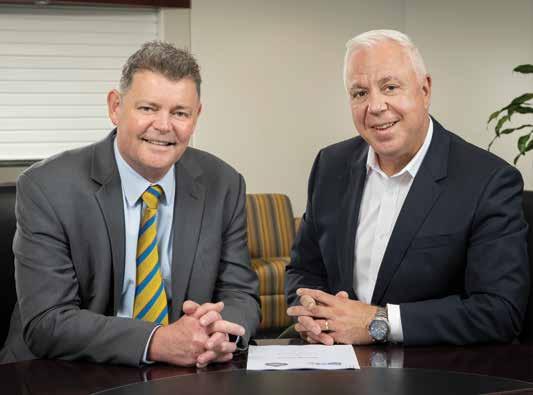
And association members, from the most junior to the most senior, are set to benefit The sponsorship funding will help stage Police Association events such as the Retiring Members Dinner, annual conference, and graduates’ dinners. It will also go, as it has before, toward a portion of the production costs of the Police Journal.
“Support of the kind the Police Credit Union gives us is invaluable, for the simple reason that it benefits our members,” he said “And benefits them significantly
“None of this would be possible without the integrity, respect and loyalty which continues to be the cornerstone of our relationship
“It can be hard for some to maintain those qualities in a business affiliation but our two organizations could not have greater regard for one another. This new agreement is the clear evidence of that. ”
Both Mr Carroll and Mr Anastasiou expect a re-signing of the agreement to take place in 2026 PJ
“None of this would be possible without the integrity, respect and loyalty which continues to be the cornerstone of our relationship.”
Letters to the editor can be sent by:
Regular mail Police Journal, PO Box 6032, Halifax St, Adelaide SA 5000
Email editor@pasa asn au Fax (08) 8212 2002
Internal dispatch Police Journal 168
A team of 10 members from the South Australia Police Golf Club competed in the Australian Police Matchplay Championships at Tocumwal, Black Bull, and Cobram-Barooga golf courses along the Murray River in November this year

In this week-long event, held every two years, teams from all over Australia tested their skills in a handicap match-play format
Since the event’s inception in 1986, the South Australia team won for the first time in 2018 And, owing to COVID-19 restrictions, this 2022 event was the team’s first opportunity to defend the title
In a fantastic team effort throughout the entire week, the SA team retained the trophy with a perfect five-out-of-five wins effort
In second place was the Queensland team with three wins and two losses for the week
SA team member Mike Prescott had a hole-in-one and won the player of the tournament as well, with five individual wins.
Any Police Association members interested in joining the South Australia Police Golf Club should visit its website at www.sapgc.com.au.
Sergeant Paul MannsCops for Kids has been supporting sick and underprivileged children in SA since 2006. Nearly 2,000 current and former police officers, and more than 100 retired members, have been donating funds to children’s charities across the state through their membership of Cops for Kids
Many of these charities support the blue family All funds are raised via payroll deduction, pension, or direct bank account transfers with each dollar on-donated to a charity Each Cops for Kids member controls the amount of his or her contribution
Every donation made to a children’s charity is made for a specific purpose A Cops for Kids committee member works closely with the children’s charity to ensure all members’ monies go directly to supporting the intended purpose
By mid-2023, Cops for Kids will make a donation that will exceed $2 million in total donations raised and given away. This is an amazing milestone for a very small charity that started by giving away $500.
All current, former and retired SA police officers are welcome to join Cops for Kids Our website is currently under renovation so, for further information, contact me at drew bynoe@police sa gov au
Drew Bynoe Chairman Copsfor Kids
www copsforkids org au
The Police Association had a second visit from former 7News weather presenter, dolphin campaigner, and now author Melody Horrill last month She came armed with a copy of her compelling memoir, A dolphin called Jock , which she presented to association president Mark Carroll
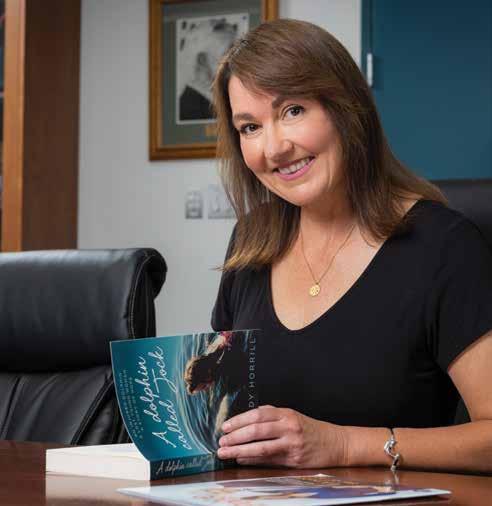
The 315-page book is, in part, a gripping account of a long, painful history of brutal domestic violence which had plagued her family But it also tells of her later involvement with the Port River dolphins and the salvation she found in them after her suffering
And Jock, of course, was the one with which she formed an instant, special bond.
Police Association members and others had first learned of her book through the Police Journal cover story A police ray of light (June 2022). For that feature, Ms Horrill had undertaken an interview with journal editor Brett Williams back in March
He wrote of not only her dolphin experience but also a critical connection between Ms Horrill and now-retired detective inspector Peter Dunstone
The two had come together after the then Darlington detective responded to the last savage attack John Horrill launched on his wife
Ms Horrill, who witnessed the incident, credited Mr Dunstone with getting her through the trauma of that day as well as the later court proceedings.
Mr Carroll was delighted to welcome her back to the association offices. He thanked her for not only attending in person to present her book to him but also for taking part in the Police Journal story
“Melody contributed so much time and effort to the production of that story,” he said “She travelled to Adelaide from Melbourne specifically for the interview with Brett and photoshoot with Peter Dunstone
“And she was so open and detailed about the traumatic family violence she had lived through That was a mark of her courage and generosity Her intention in telling her story was, after all, to help others caught in domestic violence and give them hope.
“The association is truly grateful to receive a signed copy of her extraordinary book, which will take pride of place in our library. ”
Ms Horrill, who was in Adelaide to visit family, spoke of her gratitude for further involvement with the Police Association
“It was such an honour for me to present my memoir, A dolphin called Jock , to Mark and the Police Association,” she said
“I have a deep respect and admiration for association members and the positive impacts they can have on people’s lives, as Peter Dunstone had on mine
“I feel immensely proud that my book now has a home at the association and I thank Mark, Brett and the team for their unflinching support.
“I feel I’m now a part of an extended SA police family and I’m grateful to have the chance to contribute to it in a small way ” PJ

Understaffing in regional areas comes with an impact Members regularly inform the Police Association of the effect it has on their health and well-being
Insufficient actual and/or substantive staffing thrusts members into repeated periods of on-call, and that causes fatigue
Members complete their shifts but remain on call, often on their rostered days off. This is particularly relevant to non-24/7 regional stations, Criminal Investigation Branch members, and crime-scene examiners.
These members get recalled to assist the public in emergencies and prevent crime, in line with section 5 of the Police Act (Purpose of police)
Recently before the South Australian Employment Tribunal – and awaiting finalization – was the matter of SAPOL non-compliance with the Enterprise Agreement 2021 (On call allowances and guidelines).
Clause 13.4 indicates that:
“SAPOL will not, as a matter of course, require any employee to be on call more frequently than 7 days in every 21 days Notwithstanding, the operational requirements of specific functions may require more frequent on call requirements Such arrangements will be the exception No employee, however, should be rostered or required to be on call more frequently than a total of 7 days in every 14 days Any arrangement that would require an employee to be on call more frequently than 7 days in every 14 days must only be introduced where the employee concerned genuinely agrees to it and be assessed
with respect to the requirements of the Work Health and Safety legislation Rostering of on call will provide for a clear break between periods of on call of 7 clear days This does not preclude short notice changes to on call arrangements in unforeseen circumstances ”
The requirement for a genuine agreement between the member and management is clear. Even more important is the need to consider work health and safety legislation.
With regional police work comes foreseeable risks with the potential for catastrophic outcomes In some cases, members have worked (solo) for 12 to 17 hours, driving on unsealed country roads, at night, with inadequate lighting and in poor weather conditions
There is also the question of hypervigilance owing to on-call, lack of quality sleep before driving, and long driving trips after shifts have ended This heightens those foreseeable risks.
Driver fatigue is “particularly dangerous because one of the symptoms is decreased ability to judge your own level of tiredness”, according to mylicence sa gov au
The website also indicates that “not sleeping for more than 17 hours has an effect on driving ability the same as a blood-alcohol concentration of 0 05”
And not sleeping for 24 hours has “the same effect as having a BAC of 0 10”
The National Road Safety Strategy (www roadsafety gov au) indicates that 55 per cent of road-crash deaths occur in regional areas. It outlines the rate of road-crash death as 9.6 per 100,000 people in regional Australia compared with 2 2 per 100,000 in major cities
SafeWork SA provides practical guidance for businesspeople and other duty-holders on how to manage fatigue to ensure it does not contribute to workplace health and safety risks
It indicates (in Emergency services: guideline for risk managing fatigue) that members suffering fatigue might experience:
• Difficultly in concentration
• Impaired recollection of timing and events.
• Poor judgement.
• Reduced capacity for effective interpersonal communication.
• Reduced hand-eye communication
• Reduced visual perception
• Reduced vigilance
• Slower reaction times
• Headaches and dizziness
The document highlights the risk to emergency-services personnel by:
• Negatively impacting on the control and resolution of incidents
• Increasing the opportunity for injury owing to limited human resources.
• Risk of damage to valuable plant and equipment.
Also highlighted is the link to inadequate management of long-term shift work, with consequences such as heart disease, high blood pressure, stomach and other gastrointestinal disorders, and depression
The guide recommends that the risk be managed in steps:
1. Identify all reasonably foreseeable hazards and factors that indicate risk
The road safety message that SAPOL presents to the community must align with SAPOL internal policies and processes.
Mel is a general-duties sergeant with nearly 30 years in policing She’s also a mum who has worked more than 20 Christmas Day shifts That means she has had more Christmas meals at work with her colleagues than at home with her family
But Mel is a genuinely selfless woman, with an equally geniuine sense of service – to both her community and her teammates.
In fact, she has adopted what she calls a one-in, all-in approach. She prefers that members with small children get to enjoy Christmas at home, so she has chosen to work
Her sacrifice is a big, traditional Christmas lunch and a festive afternoon with family She does her best to adapt by organizing presents early and spending as much time as possible at home
I’ve heard her say: “Working for me has never been an issue, I guess, but I’m aware of the times I’ve missed and I can’t get them back . ”
And that’s the point. Time is often the most precious gift we can give.
But the demands of front-line police work don’t always allow for police families to enjoy traditional Christmas revelry While people with regular jobs are unwrapping presents and spending time together, cops are prioritizing others’ interests ahead of their own
Matt is another good example He’s a sergeant and response supervisor who, through most of his 20 years in policing, has worked shift work . He speaks of either getting to family functions late or leaving them early. Or, worse still, missing them all together
I’ve heard the frustration in his voice when he has said: “Due to annual leave caps, not being able to get leave in summer school holidays to spend with family is a constant battle for members
“Annual leave caps doesn’t take into consideration team strength We could have a full team and can’t take leave as the district is at percentage ”
Of course, police know that the festive season doesn’t bring good cheer for everyone. For some it brings tragedy. Matt remembers the suicide of a teenage girl he knew from his footy club and dealing with her distraught family
He speaks of how “close to home” it was because he has a teenage daughter of his own He couldn’t help but think of the grief he would’ve felt had the same situation confronted him
To ask Matt about police work is to find out it’s not like a TV show He knows well the repetitive taskings like domestic violence and mental health, the things you can’t “unsee”, and the intense accountability and scrutiny on him and his workmates.
He also knows front-line cops have limited influence within the organization and must therefore be resilient and look after each other
And he’s right That resilience and care is especially important through the Christmas-New Year period when police have to confront increased behavioural offences, fuelled by alcohol and drugs Greater instances of domestic violence and crimes against the person are also a factor.
And, now, police have to prepare to face the dangers associated with the pending floods in the Riverland
Wade Burns Deputy President Police Association
Only because of police officers’ holiday-season efforts is South Australia a safer, better place in which to enjoy family and friends
Thanks and gratitude for members on the street at Christmas might be rare, if not non-existent, but that’s where families play a critical part Family support enables police to perform their role, in a job they mostly love, and helps them maintain their health and well-being.
It might seem that, at work, cops are just a PD number. But, at home, they’re much more. Those with young children understand how quickly they grow into adults So, the only thing those working police parents can do – if they can’t be home at Christmas – is find a balance
Their aim should be to create memories, even if that isn’t possible on Christmas Day And I always say that we are people before we’re police I see first-hand the sacrifice that so many police officers make at Christmas time. They have my sincere thanks and admiration.
I wish all those working shifts over the Christmas-New Year period a healthy, safe and happy holiday season
He also knows front-line cops have limited influence within the organization and must therefore be resilient and look after each other.

Hearing loss can be an occupational hazard which usually results from noise (noise-induced hearing loss, NIHL) Noise damage to the ear itself occurs because of exposure to intense impulse or continuous sound
When we talk about sound, we talk in terms of high- and low-frequency waves Sound waves are movements of air molecules that our ears translate into sound, and frequency refers to the number of cycles these waves complete in a second.

Low-frequency sounds are 500 Hz or lower while high-frequency waves are above 2,000 Hz Human ears can register sounds from about 20 Hz up to 20,000 Hz, depending upon the hearer
People with hearing loss usually have trouble hearing sounds in the higher frequency range Speech usually falls within the 100 to 8,000 Hz range People might start to find difficulty in discerning speech once it exceeds about 3,000-4,000 Hz.
Five-hundred Hz will create a rumbling sound in the lower frequency and you might feel the sound as much as hear it.
A sound in the 500-2,000 Hz range will have a tinny or horn-like quality (medium-frequency sounds) Higher frequency sounds (usually above 2,000 Hz) are mostly within our hearing When it gets up to the 10,000 Hz, it is the crashing cymbals or chirping birds Ultrasound is a frequency (above 20,000 Hz) and too high for us to hear
In general, the tone at which we speak lies in the range of 100-120 Hz for men, but variations outside this range can occur. The pitch for women is around one octave higher. A child’s speaking voice is around 300 Hz
The greatest amount of hearing loss is typically around the 4,000 Hz region, known as the “4,000 Hz dip”
Problems with your hearing might present in different ways It is important to get checked out if you have any concerns
Symptoms include:
• Tinnitus (ringing in the ear)
• Fullness or pressure in the ear
• Hearing loss.
• An occasional feeling of dizziness.
• Difficulty hearing high-pitch sounds (birds, women’s and children’s voices).
• Difficulty understanding speech in background noise
• A decrease in hearing very soft or very loud sounds
The reason police work causes hearing loss probably has as much to do with working in noisy environments as it has from using firearms But any use of guns is associated with NIHL
Many have thought shooting only once or twice a year was unlikely to cause hearing loss. But in reviewing cases of acute acoustical trauma from gunfire, over 40 per cent had noticeable acoustical trauma caused by a single shot
Ninety-two per cent of all these traumatic incidents occurred within two metres of the firearm Most (83 per cent) wore no ear protection when the traumatic episode occurred The more you shoot, the more chances of having a gun go off near your ear

Occupational hearing loss is a well-recognized condition which arises from industries or occupations (such as airline crews) with exposure to high noise levels
Many studies have been undertaken to assess the link between hearing loss and gunfire by military personnel Only a few similar studies have been conducted in respect of police officers
Police officers are potentially exposed to multiple sources of noise, including vehicle horns, barking police dogs, and traffic noise. For police motorcycle officers, the noise exposure can range from 63 decibels to 90 decibels, and up to 105 decibels on open roads
In a normal ear, the auricle (pinna) is the visible portion of the outer ear It collects sound waves and channels them into the ear canal, where the sound is amplified
The middle ear functions to connect the sound waves from the external environment and transfer them to the inner ear. Middle ear anatomy consists of intricate relationships between nerves, blood supply, and muscles.
Many have thought shooting only once or twice a year was unlikely to cause hearing loss. But in reviewing cases of acute acoustical trauma from gunfire, over 40 per cent had noticeable acoustical trauma caused by a single shot.
Model/pricing Sedan models, WRX manual (optional auto), RS manual (optional auto), tS Sport (auto): $44,990 to $56,990 Three Sportswagon models, Sport (auto), GT Sport (auto) and tS Sport (auto): $49,990 to $57,990 (all plus ORC)

Standard Steering-responsive LED headlights, dual-zone climate control, sports D-shaped steering wheel, features 11.6-inch touchscreen with Apple CarPlay, Android Auto, DAB+ digital radio and Bluetooth connectivity.
Safety AWD, eight airbags, blind-spot monitor, lane-change assist and rear cross-traffic monitoring (all models) Auto-trans models pick up full EyeSight crash-avoidance and driver-assistance package
Luggage Sedan – 414 litres (increases when rear seats folded) Sportswagon – 492 litres (rear seat in use) space up to 1,430 litres with 40/20/40 rear seats folded
Fuel All models: 63-litre tank, 95 RON premium unleaded, fuel economy 8 5 (all auto models) to 9 9 (manual) litres/100km
Model and pricing Honda HR V Vi X $36,700 (drive away), e:HEV L (hybrid) $45,000 (drive away)
Safety Front and rear parking sensors, multi-view rear camera, six airbags, numerous driver-assistance and crash-avoidance systems Extra with Hybrid: blind-spot monitor and rear cross-traffic alert .
Standard Single-zone climate control, Alpine satellite navigation, wireless Apple CarPlay, wired equipment Android Auto, DAB+ audio. Hybrid adds powered tailgate, dual-zone climate control with rear vents, heated leather-bound steering wheel, leatherette/fabric upholstery.
Fuel Both use 91 RON unleaded, Vi X 5 8 litres/100km, e:HEV L 4 3litres/100km (combined test) Warranty/servicing

Honda promises a lot with its third-generation HR-V compact SUV: a comfortable, versatile interior, improved suspension, and a comprehensive suite of safety and driver-assistance technologies
New from the ground up, HR-V comes in two variants: petrol powered Vi X and hybrid (petrol/electric) e:HEV L
Its new coupe-SUV body features a high waistline, body-coloured integrated grille, smart LED lighting assemblies, concealed rear door handles and stylish 18-inch alloy wheels

The first WRX (World Rally Experimental) in Australia quickly became a rally champion with a “bangfor-buck, pocket-rocket” reputation
Now, 28 years later, new fifthgeneration WRX is more powerful, far more refined, immensely safer and way better equipped. And entry manual sedan costs just $5,000 more than the original.
Subaru has increased its model range and introduced a new Sportswagon variant Sedan and Sportswagon are specifically designed to cater for different buyer groups with three distinct equipment levels for each body style
Longer and wider than its predecessor, WRX Sedan still offers that aggressive sports look Although toned down a little on the outside, Sportswagon offers the same performance with the added utility of a wagon.
All variants feature a new, more powerful 2 4-litre direct-injection turbocharged four-cylinder Boxer engine Drive is to all four wheels through a close-ratio six-speed manual transmission (WRX and RS Sedan models only) or new Lineartronic automatic with eightspeed manual mode
Subaru claims its new platform, with full inner frame, provides greater rigidity and torsional stiffness. The use of some aluminium body panels also shaves weight.
Superb body-hugging seats are covered in cloth, leather or Ultrasuede (model dependent) A small sports steering wheel, decent gauge layout with central multiinformation display, and quality soft-feel materials all feature
Integrated into the central fascia is a large 11 6-inch portrait touchscreen. It provides entertainment, sat nav (some models), multi-camera views, climate control and safety functionality.
Both Sedan and Sportswagon offer comfortable seating for five adults and decent cargo space
New WRX is a much more refined package to drive Even with its firm suspension it provides exceptional cornering ability while maintaining good ride comfort.
The new Boxer engine belts out 202kW of power and 350Nm of torque from a low 2,000rpm. When coupled to the improved Lineartronic auto, power delivery, even under harsh acceleration, is smooth and linear
The transmission offers slick changes and engine noise suppression is excellent
Select Sports or Sports Sharp mode for sharper throttle response and faster gear shifting Manually shifting through the auto’s eight ratios with its paddle shifters further enhances the driving experience.
Inside, it feels much roomier than its external dimensions suggest There’s plenty of head, leg and shoulder room for four adults but, with only four seatbelts, you’re out of luck if you’re a family of five.
Greater interior comfort comes at the expense of reduced cargo space (304 litres) but both models retain Honda Magic 60/40 rear seats These fold in various ways to accommodate larger items and provide up to 1,274 litres of space
A stand-alone nine-inch tablet-style touchscreen offers DAB radio, Apple CarPlay, Android Auto and satellite navigation. It’s easy to use, features large icons, and is fitted with a conventional volume-control knob.
The cabin features plenty of cup holders, a medium glovebox, lidded console bin and two USB ports up front
Both HR-V variants feature Smart keyless entry with push-button start and an electric park brake. The manually adjustable driver’s seat delivers a comfortable driving position with good visibility.
HR-V has a neat gauge layout with central MID display, which provides all necessary information including digital speedo and speedsign information The small steering wheel offers reach and rake adjustment and control buttons for various functions
Vi X features a 1 5-litre petrol engine coupled to a CVT transmission with outputs of 89kW (power) and 145Nm (torque). The hybrid features a 1 . 5-litre (Atkinson-cycle) petrol engine coupled to two small electric motors and a CVT transmission
Hybrid has more power (96kW) and substantially more torque (263Nm)
While the petrol model provides sufficient power for any task, the hybrid’s additional oomph is obvious. Hybrid gains a Sport mode (for improved throttle response) and various levels of regenerative braking via paddle shifters
On the highway, both models offer smooth and generally quiet operation, good ride characteristics and agile cornering Pushed hard, either can exhibit increased engine noise while their CVTs play catch-up
e: HEV L hybrid is the pick It offers more equipment, a better driving experience and uses less fuel.


While 2022 brought persistent challenging and volatile market conditions, Police Credit Union rose to the occasion and continued to deliver outstanding results and remain focused on supporting our members
As always, Police Credit Union continues to be driven by our strategic priorities, while being led by our core values of superior service, honesty, integrity and financial prudence . While we achieved some wonderful financial results, we also invested back into our wider community through a variety of initiatives and sponsorships, including supporting our core bond members, police officers

Since 2006, our cumulative community investment spend has exceeded $6 .1 million and just this year alone we invested $574,000 in sustainable strategic community investments. This included the renewal of important existing sponsorships along with some newly formed partnerships
This year we celebrated five years of our partnership with Crime Stoppers SA In that time, more than 3,000 people were apprehended by police and more than 9,000 crimes were solved thanks to the response of the community Our support allows this not-for-profit to offset essential operational costs associated with maintaining its free call hotline, website, rewards programme, and delivery of community engagement campaigns
Since 2006, our cumulative community investment spend has exceeded $6.1 million and just this year alone we invested $574,000 in sustainable strategic community investments.
We continued our sponsorship of the Adelaide Footy League We also continue to be naming-rights sponsor of the Hills Football League Through these sponsorships, we are proud to support grassroots sport across Adelaide and the hills
We continued our support of nurses and healthcare workers through sponsoring several events and initiatives of the Women’s and Children’s Health Network . We also supported the Barossa Hills Fleurieu Local Health Network and the Northern Adelaide Local Health Network with initiatives to recognize and give back to nurses
Our core bond is extremely important, and this year we renewed our sponsorship of the Police Association of South Australia for another five years This long-standing association allows us to continue to sponsor graduate and retirement dinners throughout the year and partner in organizing coffee vans to hand out free coffees at stations and at the Precinct Café on RUOK? Day
Our commitment to South Australian police was also seen throughout the year with a variety of small gestures of thanks This included delivering brownies to police stations across the state on St Valentine’s Day and delivering rocky road during Police Week We were proud to be the major sponsor of the National Police Basketball Championships held in Adelaide . We look forward to continuing to provide these special moments of delight in 2023
Since 2018, Police Credit Union has maintained a carbon-zero footprint having achieved our strategic reduction target which formally commenced in 2007. We continue to expand the scope of our environmental impact initiatives, including policy frameworks and initiatives designed to reduce greenhouse gas emissions, waste, and pollution
This year we introduced a carbon offset feature to our Low Rate Car Loan (special offer) which means members can opt in to offset their car’s estimated emissions for the term of their loan at no extra cost# We forward purchase offsets from Canopy Based Nature Solutions which produces high quality environmental credits to facilitate action on climate change, biodiversity loss and water quality. You can find out more about our special offer Low Rate Car Loan at policecu com au
We’re proud to share that Police Credit Union has achieved another excellent year of performance across all measures Our unwavering support to members achieved a 92 5% member-satisfaction rating. Our strong consistent results also included a prudent profit after tax result of $6.6 million, taking member reserves to $105.9 million, representing a 10.6% increase on the previous year
We pride ourselves on delivering a mix of traditional face-to-face banking with reliable and innovative digital solutions, which resulted in a score of 96 6% in the measure of member trust in Police Credit Union This year we launched our refreshed online banking platform, which continues to provide a high level of security for our members, alongside the convenience of new features and a fresh new look .
Leading Adelaide law firm, Tindall Gask Bentley is the preferred legal services provider of the Police Association, offering 30 minutes of free initial advice and a 10% fee discount.


• ICAC
• Coroner’s Court
• Criminal Law

• Motor accident injury compensation
• Workers compensation
• Police Complaints
• Equity & Diversity
• Public liability
• Superannuation claims (TPD)









Matrimonial, De Facto and Same-Sex Relationships
• Children’s issues
• Child Support matters
• General business advice
• Real estate & property advice
• Property settlements
• Pre-nuptial style agreements
• Wills and Testamentary Trusts

• Enduring Powers of Attorney
• Advance Care Directives
• Business transactions
• Commercial disputes & dispute resolution
• Advice to executors of deceased estates
• Obtaining Grants of Probate
• Estate disputes

When driving causes death, community outrage follows
Deaths by driving are often senseless and random They are always sudden and tragic – for drivers, victims, families, and first responders
A District Court judge recently had cause to reflect when sentencing a driving offender whose case garnered intense scrutiny
“You have been condemned by many for pleading not guilty to the primary offences… Even though the court found you not guilty (of the primary offences), people have decided for themselves that you are guilty of those charges I do not know how many of them would have read the court’s reasons for the verdicts
“You have been vilified for your driving that night by members of the public, many of whom expressed their views ignorant of the narrow way the prosecution case was presented against you, the evidence, or the law relating to the primary offences. All of that public attention has affected you in the many ways detailed in the sentencing material I have considered. ”
What does recent commentary about driving offences reflect?
The complexity of our modern transport systems and infrastructure has led to the development of a broad set of laws which are complex and prescriptive
All but the most informed of us have a poor understanding of the rationale behind the complexity of driving laws and the delicate policy considerations that go into their enforcement
The great breadth of laws which govern driving and licensing – some 350 sections of the Australian Road Rules alone – tells us that driving a car is not as simple as sitting behind the wheel. The situations one finds oneself in while driving cannot be definitively quantified and catalogued.
For the most part, when we drive, we are simply trying to get from A to B as efficiently as possible Many of us travel long distances to work every day We are completely reliant on transport infrastructure to do so
For better or worse, that infrastructure has developed in fits and spurts to favour travel by individual motor vehicles It’s scarcely possible to live without them
Looked at objectively, cars are onetonne metal missiles which can be instruments of death and destruction, even when driven legally.
So, the inherent danger of cars must be balanced against their necessity The law has developed to tolerate some risk Sometimes the balance is easy enough We submit to a prescriptive licensing scheme because we acknowledge there should be a minimum level of competence and accountability for all drivers There are minimum vehicle standards that prescribe things like safety features.
Even these simple balances allow a large variance in practical reality. Both good drivers and very poor drivers are able to obtain licences There are sports cars with state-of-the-art safety systems that drive alongside 30-year-old rust buckets – regulations can deem both roadworthy
Some policies and laws are more controversial but are implemented nonetheless Skulls always come off second best when they bounce on bitumen . We therefore require that cyclists and motorcyclists wear helmets, although there is a vocal minority who think this should be an individual choice, as it is in many European countries
We restrict the use of mobile phones because of their capacity to distract Their widespread use behind the wheel suggests that most people think that danger doesn’t apply to them
The great breadth of laws which govern driving and licensing – some 350 sections of the Australian Road Rules alone – tells us that driving a car is not as simple as sitting behind the wheel The situations one finds oneself in while driving cannot be definitively quantified and catalogued.
This principle becomes acute when
In SA, there is a two-tier system that criminalizes the most egregious departures from the minimum standard of driving expected on the road The less serious offending is careless driving The more serious is dangerous driving
This two-tier system is a beacon for controversy. These offences do not criminalize the outcome of the driving but rather the manner of the driving. Accordingly, there is a plethora of ways in which one can drive carelessly or dangerously, and therefore a plethora of considerations which must be weighed up when punishing such offending
The weight, speed, and inflexibility of cars means that collisions can have catastrophic consequences, even when nobody involved is trying to do the wrong thing There are times when somebody will be killed on the road and nobody will be criminally liable.

Sophie Green Hachette Australia, $32 99
Bellbird River, 1998: teacher and single mum Alex is newly arrived in the small NSW country town of Bellbird River. She has escaped the city in search of a change of pace and the chance to reconnect with her young daughter
Across town, well-known matriarch Victoria and her globe-trotting, opera-singing cousin, Gabrielle, find themselves at a crossroads in their personal and professional lives, while local baker Janine and newcomer to the district Debbie are each secretly dealing with the consequences of painful pasts.
With its dusty streets, lone pub and iron-lace verandas, Bellbird River could just be a pit stop on the road to somewhere else But the town holds some secrets and surprises, and it has a heart: the Bellbird River Country Choir
Amid the melodies and camaraderie of the choir, each of the women will find the courage to leave the past behind. And, together, they’ll discover that friends are much closer to home than they’d ever realized
For your chance to win one of the books or an in-season pass to one of these films (courtesy of Wallis Cinemas) featured in this issue, send your name, location, phone number and despatch code, along with the book and/or film of your choice to giveaways@pj.asn.au

Emma Carey Allen & Unwin, $32 99
From a terrible accident that left her paraplegic, Emma Carey has become an online inspiration for hundreds of thousands to live life to the fullest and remember that if we can, we must
There, on that helicopter, somewhere over Switzerland on a Sunday in June, came the first tiny whisper “I’m going to be okay There’s still joy here ”
When Carey was 20, she fell from 14,000 feet and survived. She tells the inspirational story of how, through one of her greatest tragedies, she found her truest self
From waking a paraplegic in hospital to learning how to use her legs again, through the six-year-long court case and now being finally free to make the most of her life, Carey highlights the importance of courage and resilience.
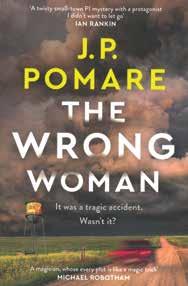
JP Pomare Hachette Australia, $32 99
A private investigator returning to the hometown he fled years ago becomes entangled in the disappearance of two teenage girls.
Reid left the small town of Manson a decade ago, promising his former chief-of-police boss he’d never return
He made a new life in the city, became a PI and turned his back on his old life.Now, an insurance firm has offered him good money to investigate a suspicious car crash. That takes him back to the place where he grew up – home to his complicated family history, a scarring relationship breakdown and a very public career-ending incident
As Reid’s investigation unfolds, nothing is as it seems Rumours are swirling about the well-liked young woman who crashed the car, killing her professor husband, and their possible connection to a local student who has gone missing.
Lexie Elliott Atlantic, $29.99
You suspect your best friend of murder – so why don’t you feel safe now that she’s dead?

Georgie, Lissa and Bronwyn have been best friends since they met on their college swimming team
Now, Lissa is dead – drowned off the coast of the remote island where her second husband owns a luxury resort But could a star open-water swimmer really have drowned? Or is something more sinister going on?
Brought together for Lissa’s memorial, Georgie, Bron, Lissa’s grieving husband and their friends find themselves questioning the circumstances around Lissa's death – and each other
As the weather turns ominous and traps the guests on the island, it slowly dawns on them that Lissa’s death was only the beginning Nobody knows who they can trust Or if they’ll make it off the island alive.

Kerry Greenwood Allen & Unwin, $32 99
Mad
Brave Tom Pitts Picador Australia, $34.99
Matt Lacey is in a mental-health facility recovering from a breakdown
Trying to work through a mess of conflicting thoughts and feelings, he writes, unwinding the story of his adolescence with the beautiful, impassive, fierce Christina.
And, as he delves into the more agonizing moments of his past, he looks directly at the pain and love that have made him who he is now
Lacey’s story is about the soaring joy and numbing nightmare of being young and hopelessly in love
1
Based on the comical and moving No 1 New York Times bestseller, A Man Called Otto tells the story of Otto Anderson, a grumpy widower who is very set in his ways
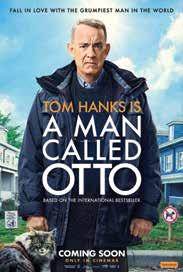
When the redoubtable Miss Phryne Fisher receives threatening letters at her home, she enlists the unflappable apprentice, Tinker, to investigate But as the harassment of Fisher threatens to spin out of control, her lover, Lin Chung, is also targeted

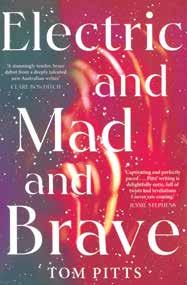
But this is not quite enough to prevent Fisher from accepting an invitation to a magnificent party at the house of the mysterious Hong
When the party is interrupted by shocking tragedy, Fisher gathers all her unerring brilliance to track down the miscreants
With some unlikely assistance, she is in a race against time to save a pair of young lovers from disgrace and death
When a lively young family moves in next door, he meets his match in quick-witted and very pregnant Marisol, leading to an unlikely friendship that will turn his world upside down.
It’s a funny, heart-warming story about how some families come from the most unexpected places
Cast: Tom Hanks (Otto Anderson), Mariana Treviño (Marisol), Rachel Keller.
19
Babylon is a tale of outsized ambition and outrageous excess. Set in 1920s Los Angeles, it traces the rise and fall of multiple characters who are a combination of real and fictional people

And it is during an era of unbridled decadence and depravity in early Hollywood as the movie industry transitions from silent to talking pictures – the talkies.
Cast: Brad Pitt (Jack Conrad), Margot Robbie (Nellie LaRoy), Tobey Maguire (James McKay), Olivia Wilde
December 26
Daring outlaw Puss in Boots discovers that his passion for peril and disregard for safety have taken their toll Puss has burned through eight of his nine lives, though he lost count along the way
But with only one life left, Puss will have to humble himself and ask for help from his former partner and nemesis: the captivating Kitty Soft Paws
In their quest, Puss and Kitty will be aided by a ratty, chatty, relentlessly cheerful mutt, Perro
Together, the trio has to stay one step ahead of Goldilocks and the Three Bears Crime Family, “Big” Jack Horner and terrifying bounty hunter The Big Bad Wolf

Cast: Salma Hayek (Kitty Soft Paws), Antonio Banderas (Puss in Boots), Florence Pugh (Goldilocks), Olivia Colman (Mama Bear), Ray Winstone (Papa Bear), Samson Kayo (Baby Bear)
December 26
I Wanna Dance with Somebody is a powerful celebration of the incomparable Whitney Houston The film is a no-holds-barred portrait of the complex and multifaceted woman behind The Voice

Houston rose from New Jersey choirgirl to one of the best-selling and most awarded recording artists of all time
I Wanna Dance with Somebody takes audiences on an inspirational, poignant and emotional journey through Houston’s trailblazing life and career
It features show-stopping performances and a soundtrack of the icon’s most beloved hits
Cast: Naomi Ackie (Whitney Houston), Tamara Tunie (Cissy Houston), Clarke Peters (John Houston), Stanley Tucci (Clive Davis)
Four episodes, 179 minutes $24.98
Single mum Jodie runs a hairdressing salon One day at work, she glances out of the window and, in a split second, witnesses a killer and his victim moments before a murder.
She becomes the target of a terrifying campaign of witness intimidation by a street gang As the pressure builds on Jodie, her family’s safety becomes increasingly precarious


But Jodie’s mother, Cathy, continues to support her daughter even after the gang turns its attention to her
Being placed under police protection, Jodie grapples with whether or not to testify against the killer who is trying to terrorize her into silence

Witness Number 3 asks the viewer: “Would you risk your life to do the right thing?”
Cast: Nina Toussaint-White (Jodie), Sue Johnston (Cathy), Sion Daniel Young (PC Ivan Barkas), Clare Dunne (Detective Whelan) TRAILER youtube com/watch?v=xUgBztSh17Q
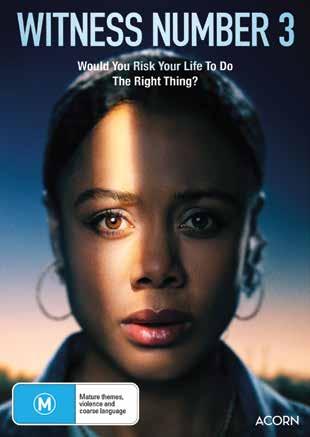
The Police Journal has 10 copies of Witness Number 3 for giveaway. For your chance to win one, send your name, location, mobile number and despatch code to giveaways@pj.asn.au.
Clear and bright, with intense, aromatic wafts of lemon, lime citrus, fizzing sherbet powder and a slight reminiscence of Dad’s lemon-scented shaving cream
Despite its intensity, the nose remains controlled and focussed throughout In the mouth that same lime citrus element remains prominent where it is now joined by just a hint of fresh grapefruit
There is a lovely interplay between fruit weight, mouthfeel and focus and the wine remains light on its feet as it dances through the mouth with a clear end point always the goal
It finishes long and refreshing
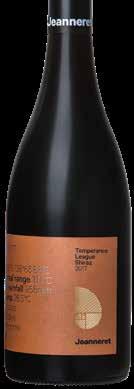

Jeanneret
Released at five years of age, this single vineyard Shiraz is drinking wonderfully well. A nose of spice, plums and dark fruits are complemented with gentle oak .
Mid-weight but gutsy on the palate, this is a classic Clare Shiraz Screaming out for the barbecue but delicious on its own Alcohol 15 5%
Chalk Hill, McLaren Vale
Grapes from this limited release wine were grown in two vineyards located in Blewitt Springs The individual parcels were picked and handled separately prior to blending
This is a vibrant and perfumed wine with notes of strawberry, dark cherry, and subtle spice. Blewitt Springs Syrah has a textured front and mid-palate with layers of bright red fruits combined with fine tannins.

From page 22
From page 25
2. Assess risks of injury or harm arising from each identified hazard
3. Implement control measures to eliminate or minimize the risks.
The enterprise agreement (clause 13. 5) also enforces considerations to work health and safety:
“The frequency, duration etc of being on call is to be established through consultation with the employees affected and if requested by the employees, their representatives, having particular regard to Work Health and Safety considerations ”
SAPOL general orders (Work Health, Safety, Welfare and injury management, Fatigue management) indicate that:
“The Executive Leadership Team must take reasonable steps to ensure the business or undertaking has and uses appropriate resources and processes to identify and manage the risks associated with fatigue ”
The onus is on the ELT to comply with the SafeWork SA emergency services check list (working hours and fatigue), reassess regional on-call policies –at both service and local levels – and ensure actual staffing complies with the enterprise agreement (clause 13)
All foreseeable risks must be minimized if not eliminated . The provision of two persons on call to share regional driving is an example.
The road safety message that SAPOL presents to the community must align with SAPOL internal policies and processes
The inner ear is made up of the cochlea – the auditory nerve that connects to the brain.
Problems with hearing often come from a disease which damages the bones in the ear and stops sound getting through to the brain An audiogram can measure this at specific frequencies and work-related damage shows up as a recognisable pattern of hearing loss
When there is a difference between ears, it is important to rule out things like wax in the outer ear, nerve damage, or tumour of the inner ear
About one in 1,000 newborns is deaf, one in 300 children is affected with congenital hearing loss of a lesser degree, and an additional one in 1,000 becomes profoundly hearing impaired before adulthood.
A cochlear implant might be a solution The implant receives sound from the outside environment, processes it, and sends small electric currents near the auditory nerve These currents activate the nerve, which then sends a signal to the brain The brain learns to recognize this signal and the person experiences this as hearing
Amplification via hearing aids and/or assistive listening devices also provides options for many people with a hearing impairment. With the advancements in hearing aid technology, benefits can come in a variety of listening situations, including background noise
Hearing will decline with age but decreasing the risk of noise damage is important Be aware of the amount of the noise at work Protect your ears while shooting The audiogram is a simple test and is readily available Hearing aids or implants provide some alternative but protection is better than cure.






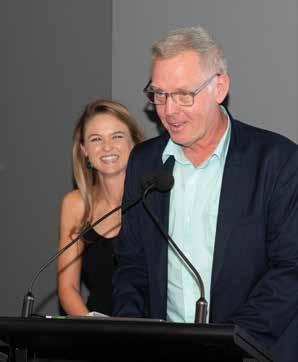
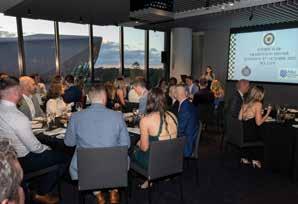





From page 31
You might have noticed Police Credit Union has a new look with a new logo and tagline Bank On Us. While our outgoing logo served us well for more than a decade, it was time for a refresh. As a leading alternative to the major banks, it’s vital our brand remains contemporary, representative of current and potential members and appeals to a broad audience Our unwavering support to police officers remains unchanged and we continue to honour our police heritage with reference in the logo and through our Platinum package which has the same ongoing exclusive benefits and discounts.
As a mutual and customer-owned organization, we put our members first by reinvesting 100% of profits back into the business to continue to provide market-leading, highly competitive products and services
For more information about your exclusive benefits as a Platinum member, including select discounts on loans and $0 loan package fees – a saving of up to $420*, please contact your local Platinum Relationship managers, Glenn Lewis on 0421 243 741 or Ryan Mountford on 0437 286 804. They’d love to provide you with their personal banking service. Please view more special Platinum benefits at policecu.com.au/platinum. You can read about the last year in detailed review in our annual report on our website
Police Credit Union Ltd ABN 30 087 651 205
AFSL/Australian Credit Licence 238991 Terms, conditions, fees, charges and lending criteria apply. Full details upon request. All information correct as at 01/11/2022 and subject to change. Police Credit Union reserves the right to withdraw or amend product features at any time. *Excludes Business Banking &/or Commercial Loans and loans to a Trust or Self-Managed Super Fund. #Estimated Car emissions will be offset for the term of the loan. No further discounts apply.
In the same way as innocent driving can lead to death, dangerous driving often does not lead to a collision. There is a suite of criminal offences for such driving: excessive speed, misuse of motor vehicle, street racing, and driving under the influence are all offences which punish driving that is dangerous but does not lead to injury or death
The penalties for these offences are mostly regulated and rarely cause controversy
The complexity and controversy arises when some manner of careless or dangerous driving causes injury or death. These offences attract nominally harsher penalties because of the outcome – but it is the manner of driving that leads to the criminal culpability.
Because it is still the manner of driving that leads to the culpability, the offending driver is punished for his or her moral culpability in causing that outcome, as well as the outcome itself This interplay is what can lead to such a variance on penalties for serious driving offences and that variance can lead to community outrage
How many road users can say they have never glanced at their phones while driving? How many can say they have never been distracted by a source external to the car, like a flashy billboard or an odd pedestrian? Even the slightest distraction can lead to a collision
What should be the appropriate penalty for a driver who is travelling on the freeway at 100km/h and causes a crash by glancing at his or her phone?
What about a driver who, involved in a collision, hasn’t cleaned his or her front windshield properly and has his or her view impaired when the sun shines through the dirty glass?
What about a driver who fails to turn on his or her headlights during a sudden onset of fog and therefore collides with another?
Most would agree that the penalties in these examples should be much less than for a driver who is high on drugs or evading police in a pursuit and causes a death, although in both cases the outcome for the deceased’s family is no easier to bear.
There are protections enshrined for police officers and other emergency workers who undertake urgent-duty driving in the course of their work . But, even then, there will be circumstances in which they are liable for dangerous or careless driving
There is no easy answer and the law cannot legislate away all risk Like any offending on the criminal calendar, attempts to legislate loopholes closed will lead to incomprehensible legal complexity and even less public understanding, which invariably leads to greater public outrage.
Any punishment meted out will never be adequate compensation for the loss of loved ones But for so long as we need cars, we will need to accept the risks that come with them
Gathered and waiting before the start of the parade
Nathan Kerr, Stuart Caldwell and Scott Butler
Graduates march off after the parade
Cassidy Hurn, Victoria Lauriello, Jacinta Henderson

Girish Kumar, Police Association vice-president Daryl Mundy and Stuart Caldwell



Graduates on the parade ground


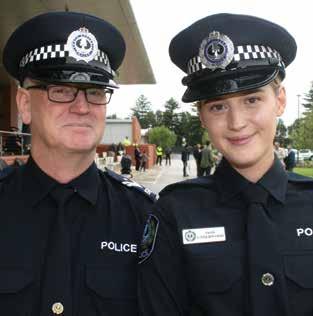
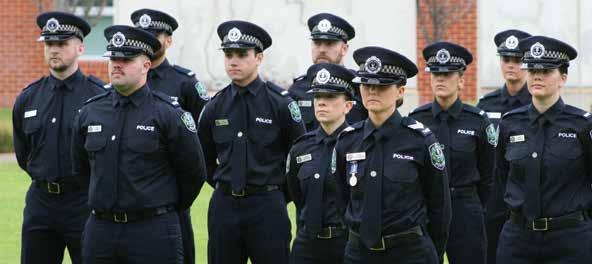
Kate Bailey embraces a coursemate

For the full version of The Last Shift, go to PASAweb at www.pasa.asn.au
Curtis Grant Garritty Glyn Jones Brian MattnerDrug
35 years’ service Last Day: 05 10 22
Comments…
“I thank the Police Association for its support over all those years
“I worked at Para Hills patrols, Surveillance (SAPOL and NCA), Salisbury patrols, Elizabeth patrols (sergeant), Elizabeth Traffic (sergeant), Road Policing Section – North (both as a Tactical and Response sergeant) and, finally, Drug Testing Unit sergeant
“During my service, I have worked with many outstanding SAPOL members It has truly been an honour and a privilege to have served with those members, especially in the Northern District
“Remain strong, continue to strive for what is right and always lead by example. Continue to excel at what you do. ”
EMES
42 years’ service Last Day: 26 10 22
Comments…
“I don’t think any of us at the start of our careers looked at figures of 20, 30 or 40 years of service, but that is where we find ourselves now.
“I am very grateful to the forwardthinking members who, from years gone past, started the association, created the health fund and credit union, and worked hard for the old pension scheme


“Those decisions, hard work and planning have enabled members to be really well supported over our working lives and into the future
“To all members: be safe, enjoy your careers, and don’t forget that family and friends are what you have at the end. ”

Serious & Organised Crime
45 years’ service Last Day: 16.11 . 22
Comments…
“I sincerely thank past and present association staff and delegates for the outstanding service provided to association members
“It has been a privilege to have served with SAPOL over the past 45 years, the majority of time within Crime Service
“I have had the opportunity to work alongside truly inspirational and dedicated sworn members and non-sworn staff over the years. I have been very fortunate to have served under so many exceptional leaders and work/life mentors
“I wish all current SAPOL staff all the best for the future and implore the association to continue the good fight for pay and conditions for those still serving
“Having sadly lost so many colleagues to suicide over the journey, I respectfully suggest mental health should remain a significant association and SAPOL priority. ”

45 years’ service Last Day: 31 08 22
Comments…
“I thank the Police Association both past and present for its ongoing support of its membership
“Having spent my entire career as a front-line operational member I have experienced the highs and lows that policing the streets brings.
“I have thoroughly enjoyed my time, working with some great people over these years


“To those who continue to fight the good fight, stay strong to your beliefs
“My last seven years were spent at Mt Barker patrols where I had a patrol team of young and not-so-young patrol officers who went about their duties with zest and vigour I thank all of them for carrying me through those last few years
“My time was well and truly up, and I knew this because my tolerance with the people that police deal with on a regular basis was gone. ”
Day shift at Christies and we were called to a shoppie at Colonnades. A man had stolen some butcher’s knives and was sitting outside the shopping centre clutching them on his lap. As we approached, he stood up and started to walk towards us still holding the knives He walked between a wall and a parked Armaguard van We split up to either end of the van and were able to keep him there My partner drew his firearm as the man had the knives pointed at him I had my taser trained on him The Armaguard officers thought he was about to rob them and were trying to exit the van to deal with him I tried to keep the van door closed so they’d stay inside. The man saw that he was up against both police and Armaguard officers and put the knives down . He was safely detained and later said he’d hoped to commit suicide by cop
On patrols at Christies Beach, we were nearing the end of our last night shift when our brevet sergeant called in a fail-to-stop, which was soon followed by: “The car has hit a wall.” Everybody on the team was there within minutes A 17-year-old was driving the car, which was stolen, and her boyfriend, with her, was breaching his home detention They had turned into a retaining wall at Bunnings The driver was in a very bad way and died, but her boyfriend got out reasonably unharmed It was quite a big job but everyone rallied I came away feeling completely supported by my teammates . The communication was amazing and everyone was checking in with each other to make sure the other was okay. I was grateful to have such a fantastic group of people
At CFIS, I was put in touch with a young single mother who had just fled her abusive partner in Queensland. He had repeatedly raped and assaulted her and had broken her jaw over a bedside table Whenever we spoke about him, her whole body would involuntarily shake She was terrified and suffering PTSD She had a one-year-old with him and was trying to start a new life away from him . He was avoiding Queensland police and spooking her into thinking he was in SA . He got other family members to contact her and breached his bail and intervention order For weeks I worked closely with a detective in Queensland to locate him at court, where he was promptly arrested The next month was very busy gathering victim statements and evidence The hard work was worth it for a guilty plea and a six-year sentence
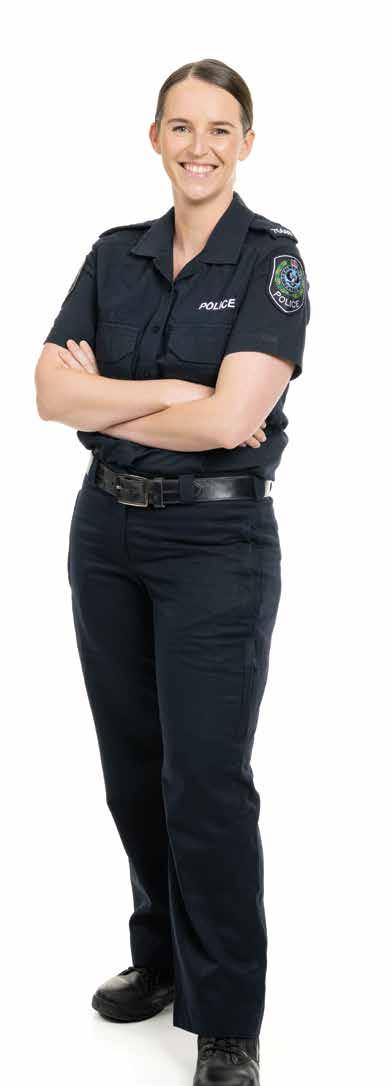
“Whenever we spoke about him, her whole body would involuntarily shake. She was terrified and suffering PTSD.”
